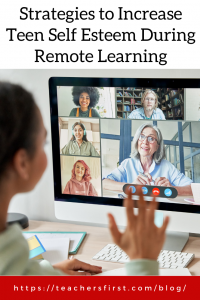Did you know that May is Mental Health Month? Mental Health America and its affiliates have spent this month raising awareness since 1949, but it’s a particularly important topic today. The COVID-19 pandemic has significantly impacted our students’ lives. Everyday experiences that helped build their self-esteem suddenly shifted to school closures, social distancing, quarantines, and remote learning. The changes students faced during the pandemic have impacted their social and emotional well-being. Self-esteem is a critical component of mental health. Higher self-esteem has a positive impact on students’ social and emotional well-being.
Building a community of learners is a critical component of face-to-face classrooms and lays the foundation for positive self-esteem for our students. Low self-esteem can result in challenges socially or academically, and may stem from separation from friends, stress from distance learning, or many other factors. Integrating social and emotional skills allows students to understand their strengths and challenges, manage their emotions, and develop other essential skills to be successful in life. The methods listed below are ways to integrate social and emotional (SEL) learning skills to promote positive self-esteem in remote classroom environments.
Check-Ins
It is essential to schedule regular check-ins with the students and their families. Check-ins allow you to monitor a student’s overall well-being and have the family share their perspective, since you aren’t sharing a physical space with the student. Use Google Meet or Microsoft Teams for virtual check-ins. Share a weekly Google Form or Microsoft Form with your students and their families and ask questions such as, “What are some things you wish your teacher knew about you?” You could have younger students select emojis that best represent their social and emotional well-being. Check out our Twitter Chat archives for a previous chat about digital tools and resources for self-regulation for more ideas.
Small Groups
Use the breakout feature in your virtual meeting space or schedule small groups to meet throughout the day. Dr. Catlin Tucker has a fantastic post about station rotation in the era of social distancing. Small groups provide a personal connection and allow you to give targeted feedback to positively impact students. Read our April 1 blog post, ”Station Rotation and Remote Learning,” for more details and information.
Collaboration
Collaboration is a 21st Century skill that also supports social-emotional skills. Collaborative activities organically integrate problem solving, teamwork, perseverance, conflict resolution, and many other skills. Providing activities for collaboration can help boost students’ positive self-esteem because they are not working in isolation on assignments and activities.
Class Meetings
It is essential to integrate social and emotional skills into our academic activities, but our students can also benefit from explicit instruction to promote positive self-esteem. For example, teaching students how to set and evaluate goals puts the focus on their positive growth. Your mindset also impacts your students’ mindset. Model flexibility and perseverance during remote learning and discuss it during your meetings with the class.
Voice and Choice
Provide students with choices to demonstrate their knowledge of the learning objectives. Providing the option for students to publish their work for positive feedback from their peers can also impact their social and emotional well-being. Students can publish their work in your LMS or Flipgrid (reviewed here).
Focusing remote classroom experiences to promote positive self-esteem by concentrating on students’ social and emotional well-being is essential to providing stability during a difficult time. With this focus, we can create safe and empowering learning environments for our students. Visit our Twitter chat archives for tools and resources about using technology to strengthen social and emotional learning. What strategies and resources are you using to promote positive self-esteem during your remote learning experiences? We’d love to hear them in the comments below!


